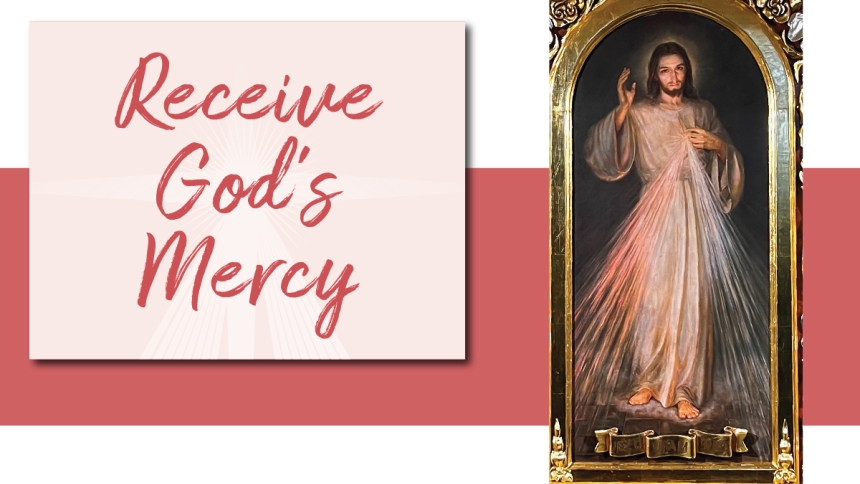
On Divine Mercy Sunday, the Second Sunday of Easter, the faithful celebrate the depth of mercy that God lovingly invites humanity to receive.
God’s bountiful mercy is promulgated through the diary of the humble Polish worshiper Helen Kowalska—venerated in the Catholic Church as St. Faustina Kowalska—when she articulates her mystic encounters of Christ’s divine mercy.
Institution of Feast Day
Divine Mercy Sunday was established by then Pope John Paul II in 2000 at the canonization Mass for St. Faustina Kowalska. The feast day is a living witness to the love God has for creation and the unfathomable mercy to atone sinful shortcomings.
In God’s divine love and wisdom, providentially, Saint Pope John Paul II died in 2005 on the Vigil of the feast day he established for the universal church.
During the 2016 World Youth Day celebrations in Kraków, Poland, then Father Walsh visited St. Faustina’s Shrine in Poland. The piousness of the shrine speaks the message of her visions: “Mercy flows from the Sacred Heart of Jesus,” he reflects.
The image of divine mercy that St. Faustina saw is the revelation of what God is offering, Bishop Walsh explains. The rays that stem from Christ’s heart are typically portrayed as red and white. Red embodying the sacred blood and white being the purification of baptismal waters.
“In atonement of our sins, sacred blood and water poured from Christ’s side at Calvary, and the rays illuminated in the image give living witness to the gift of his sacred mercy and eternal salvation,” said Bishop Walsh.
The Chaplet of Divine Mercy (available in the sidebar) is prayed using rosary beads and elicits the essence of Christ. This reception of mercy leads to the conversion of heart and deepens one’s relationship with God, offers Bishop Walsh. “Divine mercy is a healing balm with the power to release us from the chains of sin.”
According to St. Faustina’s diary, “The souls that say this chaplet will be embraced by [Christ’s] mercy during their lifetime and especially at the hour of their death.”
The more one encounters God’s loving mercy, the nourished heart grows in conversion and consequently renders prayer and spiritual works for another’s encounter and growth. This is essentially the essence of Divine Mercy, instructs Bishop Walsh.
The Chaplet’s simplicity makes it an applicable prayerful reflection for any sinful or challenging context because God’s mercy is all encompassing.
The chaplet can be offered as a novena at any point during the liturgical year, but it is contextually appropriate to pray nine days before Divine Mercy Sunday, which starts on Good Friday.
As described in St. Faustina’s diary, Christ instructed the faithful to pray for a different category of individuals on each of the nine days (e.g., all sinners and all religious receive prayerful intentions on the first and second days of the novena). “By this novena, I will grant every possible grace to souls,” St. Faustina wrote.
Plenary Indulgence
God’s mercy is so fruitful to Divine Mercy Sunday that Saint Pope John Paul II instituted an opportunity for the faithful to receive a plenary indulgence on the feast day.
To ensure specificity, the passage below from EWTN describes the circumstances for the indulgence.
A plenary indulgence, granted under the usual conditions (sacramental confession, eucharistic communion and prayer for the intentions of Supreme Pontiff) to the faithful who, on the Second Sunday of Easter or Divine Mercy Sunday, in any church or chapel, in a spirit that is completely detached from the affection for a sin, even a venial sin, take part in the prayers and devotions held in honor of Divine Mercy, or who, in the presence of the Blessed Sacrament exposed or reserved in the tabernacle, recite the Our Father and the Creed, adding a devout prayer to the merciful Lord Jesus (e.g., Merciful Jesus, I trust in you!")
May the Paschal mysteries of Christ come to fruition in the hearts of all the faithful, and may the depths of God’s mercy be the pinnacle of such fruition.
The Chaplet of the Divine Mercy
- Begin with the Sign of the Cross, and then pray one Our Father, one Hail Mary and The Apostles Creed.
- Then, on the Our Father Beads, say the following: “Eternal Father, I offer You the Body and Blood, Soul and Divinity of Your dearly beloved Son, Our Lord Jesus Christ, in atonement for our sins and those of the whole world.”
- On the 10 Hail Mary Beads, say the following: “For the sake of His sorrowful Passion, have mercy on us and on the whole world.”
- (Repeat steps 2 and 3 for all five decades).
- Conclude with (three times): “Holy God, Holy Mighty One, Holy Immortal One, have mercy on us and on the whole world.”






